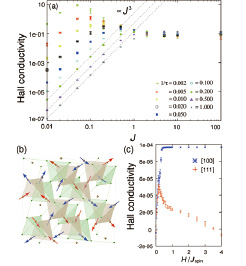Topological Hall Effect in Spin Ice Conduction Systems - Application to Exotic Hall Response in Pr2Ir2O7 -
M. Udagawa
Topological Hall effect (THE) is a hallmark of modern condensed matter physics. We have addressed the THE in conduction electron systems interacting with spin ice, which is one of the prototypical magnetic states arising from geometrical frustration. This setting is relevant to Pr2Ir2O7, where conduction electrons due to Ir 5d bands interact with Pr magnetic moments forming spin ice. In this compound, Hall conductivity shows highly non-monotonous and anisotropic behavior [1], while the conventional mechanisms of Hall conductivity lead to monotonously increasing Hall conductivity with magnetic field.

Fig. 1. (a) J and damping rate dependence of Hall conductivity of the Ising Kondo lattice model on a kagome lattice. Clear J3 scaling can be observed in a weak-coupling region. (b) Schematic picture of double pyrochlore lattice. On one sublattice (brown), localized moments reside, while on the other (green), conduction electrons are defined. (c) Magnetic field dependence of Hall conductivity in the Ising Kondo lattice model on a double pyrochlore lattice. Steep kink is observed for H||[111], signaling the onset of kagome ice correlation.
To address this peculiar Hall response, we started with the construction of general theory of THE in spatially inhomogeneous systems. As the simplest case, we considered Ising Kondo lattice model on a kagome lattice with [111]-type easy-axes anisotropy. Through the numerical diagonalization of this model, we found a characteristic crossover with respect to spin-electron coupling, J (Fig 1. (a)). For small J, the Hall conductivity is scaled as ∝ J3, where real-space spin scalar chirality spanned by three localized spins acts as an independent skew scatterer. On the other hand, for large J, the Hall conductivity converges to a finite value, where the electron spins are forced to align parallel to the localized moments.
Motivated by the clear identification of J3 scaling in weak coupling region, we applied the third-order perturbation theory [2] to the Hall conductivity of Pr2Ir2O7, in which the coupling between conduction electrons and Pr moments arises from superexchange process and is small. To describe this compound, we adopt the Ising-type Kondo lattice model on a double pyrochlore lattice, where conduction electrons defined on one pyrochlore sublattice interact with localized Ising moments residing on the other pyrochlore sublattice (Fig 1. (b)). We calculate Hall conductivity by combining the third-order perturbation theory and Kubo formula.
As a result, we could successfully reproduce the non-monotonic behavior of Hall conductivity (Fig 1. (c)). In particular, for [111] magnetic field, the Hall conductivity shows steep peak at a relatively low field, then decreases, leading to sign reversal. These results well capture the main features of experimental data. One of the main implications of our analysis is that the peak for H||[111] can be associated with the crossover from zero-field spin ice state to kagome-ice-like state[3]. So far, this peak has been associated with the spin ice (2-in 2-out) to fully saturated state (3-in 1-out and 1-in 2-out)[1,4]. We thank R. Moessner for fruitful discussions.
References
- [1] Y. Machida et al., Phys. Rev. Lett. 98, 057203 (2007).
- [2] G. Tatara and H. Kawamura, J. Phys. Soc. Jpn. 73, 2624 (2004).
- [3] M. Udagawa and R. Moessner, submitted to Phys. Rev. Lett.
- [4] T. Tomizawa and H. Kontani, Phys. Rev. B 82, 104412 (2010).
